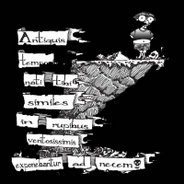A Native’s Guide to Boston, Part 1: The Underground by G. Adams
I already have several blogs that discuss several topics, so when BBT invited me to contribute to their blog, I wasn't immediately certain about what I could bring that was new. But then it occurred to me that as BBT is published here in Boston - a town I know well-- but distributed all over, I might talk a little bit about the town I live in, to bring some of you who might not know this town very well a bit closer to the truth.
Boston's a great place, if you didn’t already know. It's a relatively small city --some call it a walking city-- but the even better news is that visitors don't have to walkwe have one of the oldest, yet most reliable, public transportation systems in America.
What I like msot to do, when I’m feeling adventurous and maybe a little off my head—you know, that mix of near-suicidal recklessness and despair that can grab you after another day has gone irretrievably sour and the faces of strangers stab at you like icepicks, where the cheap beer and the-god-knows-what you lifted from your roommate’s stash—it might have been powder, it might have been pills, it might have been smoke laced with anything from meth to drain cleaner to banana leaves—when all that settles in and it’s a lifetime between the beatings of your useless heart, that’s when you should do what I do when such a state take me, and walk the city underground, in the trolley tunnels, down there with the taggers and the homeless and the rats.
And the other things, but I’ll get to that.
You can get in by Northeastern University, over on Huntington Avenue. Just walk yourself down into the hole, there. You might think you’ll need a flashlight, but don’t bring one. Lights just cause problems.
Now, these trolley tunnels are old, they go way, way back, and the man who designed them died in them.
He was haunted by dreams of his tunnels, the way that they run beneath the city like hollow snakes, and one night, when he was sleepwalking through the underground in his cap and gown, with an old bullseye lantern, --this was 1884, remember -- whack, he met his end beneath the running metal wheels of the last car out of what was then Tremont Station.
True story, based on fact.
Part of the problem was that those old cars, they had shitty lights, and worse brakes, and another part of the problem was that these guys, the drivers, they were sort of drunk with the power of those early cars, and also, to be completely honest, they were frightened to be down there, as well.
The tunnels weren't the well lit, back then, as I have said, and when you're in an open car, chugging through the earth at thirty miles an hour, with just an oil lamp to see by, well, things get a little spooky, shit gets a little strange. Things would happen, and people would talk. You would get stories going 'round--
--like the car the went out of Park Station, at 3:15, so full of people that you could hear the rails creak beneath the weight, and that rolled into Government empty, picked clean as the stem you toss away after you have eaten all of the grapes.
--like about the stretch of track between South Station and Broadway, about by Fort Hill Channel, that is simply dead. You can't hear it too well, on the train, but if you ride the Red Line at all you have probably been through it, and maybe you thought that quick stutter of silence was your ears popping, but it's something else altogether. There simply is no sound in this spot, and the drivers know it and they run the cars through so quickly that the dead spot is no more than a ripple in the thrumming of the subway cars and the constant talk. You actually feel it more when you are asleep. It stays with you then, it clings. It’s difficult to keep a light burning in that place. In the old days, the gaslights would all gutter out. Even today, the electrics quiver, and the subway lights strobe until the car is through.
--and there's been talk among the conductors as long as there's been trains, about how they might see something that looks like a baby, or a toddler, a lost child on the tracks, and they might stop to get a closer look, but it was never children, though, or at least not your typical children, not like the kind that you'd usually see. After the few drivers who'd survived close looks at the things told their stories around, the rest knew better, and they all took to rolling their cars over anything that might wander into their way.
Especially anything that glowed.
This sort of thing happened so much on the Blue Line, so many little bundles of white dash out from the walls and onto the tracks, or they thump into the sides, or maybe they get hit, and you get this sound, like a melon being popped on the rails, that the drivers call the run between State and Aquarium the Nursery.
And one more: when they came down and found Mr. I-Designed-These-Tunnels dead in his bathrobe and slippers, sure, he'd been whacked by a three-car trolley, and sure, it was to expected that he would be in bad shape, but brother, bad don't even begin to get into the shape he was in.
Look at it this way: even if you get hit by a train--hard--even if that train sends you to bits, into gobbets-- there should be some accounting for those gobbets. There should be enough parts there, when you sling them all together, to make up one person, no more, no less.
Well, that wasn't the case, here. What they gathered together in a basket and brought up into the light, when they put it all together, so to speak, was about two-thirds our friend and neighbor, and some inestimable percentage of something else, something which had been knocked apart when the train hit it, something that got very cold when it was dead. Anything more about it-- what it was, where it came from, what it was doing down there, with our little urban transportation chief-- that was just guesswork.
You want a real treat, then someday, go down to Reservoir, or Riverside, or North Station, or any station where the lines end and the empty cars are stacked up like dead soldiers, and watch what they blast free from the underside of the trains with high pressure hoses.
It'll be worth your token, trust me on this one.




2 comments:
Love it!
I wonder how much is true?
Where can I read more on this subject?
Thanks for the kindness!
My next few posts will deal with the lesser known histories of the city, so I guess you can read more right here.
Post a Comment